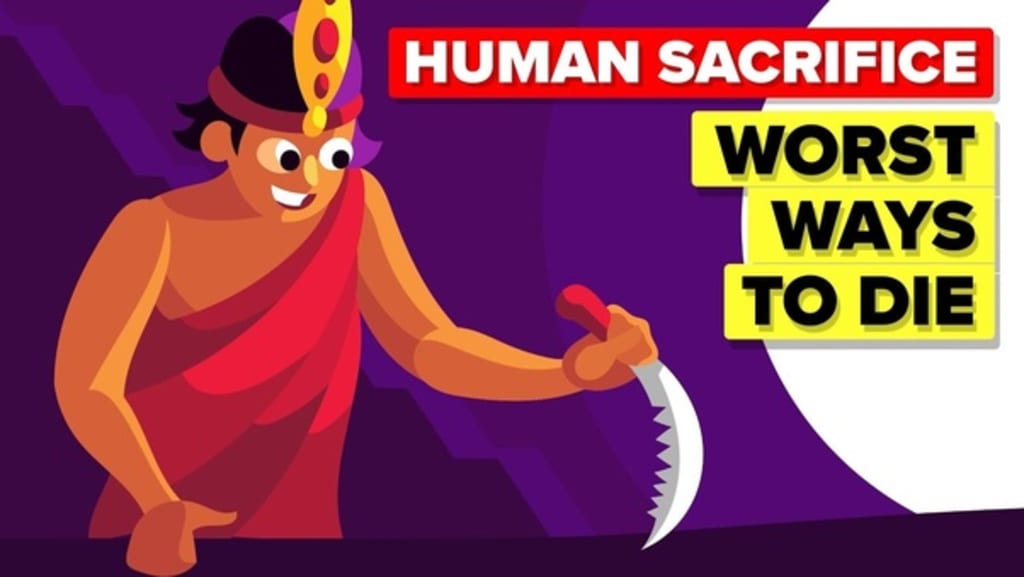Content warning
This story may contain sensitive material or discuss topics that some readers may find distressing. Reader discretion is advised. The views and opinions expressed in this story are those of the author and do not necessarily reflect the official policy or position of Vocal.
Why is human sacrifice considered one of the worst ways to die?
Today's intense narrative is going to make you extremely grateful that you live in the 21st century. We're talking about real-life human sacrifices that ancient tribes made to their gods. Sometimes, this meant sacrificing a loved one, such as a daughter or son, in order to ensure a bountiful harvest. This was a horrific practice, and it's one of the worst ways to die. Check out our new narrative to learn more about this dark chapter in human history. 💀🔪🩸

Today's intense narrative is going to make you extremely grateful that you live in the 21st century. We're talking about real-life human sacrifices that ancient tribes made to their gods. Sometimes, this meant sacrificing a loved one, such as a daughter or son, in order to ensure a bountiful harvest. This was a horrific practice, and it's one of the worst ways to die. Check out our new narrative to learn more about this dark chapter in human history. 💀🔪🩸
- In ancient civilizations, particularly in regions like Peru, the Maya culture, the Aztec culture, and the Inca culture, the practice of human sacrifice was prevalent. This article explores the harrowing rituals and beliefs associated with these sacrifices.
- During the mid-1400s in what is now Peru, specifically the Chimú state, archaeologists uncovered a mass grave containing the remains of 137 boys and girls. The bodies exhibited signs of unimaginable suffering, suggesting that these children had endured a horrific fate. The experts concluded that the sacrificial ritual involved the removal of their hearts, reminiscent of scenes from an Indiana Jones movie.
- Human sacrifices were not limited to the Chimú state but were widespread across ancient civilizations south of the U.S. border. While the Incas did not have a written record, burial sites and accounts from the Spanish conquerors shed light on their practice of sacrificing children in the name of their gods.
- Children were selected for sacrifice based on their pristine appearance, as they symbolized purity and were considered untouched. Boys and girls aged six to fifteen were often chosen and treated with utmost care leading up to their execution. They were provided with abundant food, treated as royalty, and adorned with exquisite garments and ornaments.
- The sacrificial process was far from merciful. In the Inca culture, the children were subjected to a grueling journey up a mountain, enduring harsh conditions and consuming coca leaves to sustain themselves. Before their death, they were administered a drug to alleviate their fear and pain, although its effectiveness varied. Strangulation or blunt force trauma, such as being hit over the head, were common methods employed to end their lives.
- Other ancient cultures employed different forms of sacrifice, including heart extraction, decapitation, skin flaying, and even cannibalism, sometimes perpetrated by the victims' own parents. For instance, among the Aztecs, being part of a sacrificial rite was considered an honor, and it was vital for the victims to display acceptance and gratitude. Failure to do so was seen as an insult to the gods and brought shame upon the sacrificed individuals.
- The rituals differed across civilizations, but the underlying motivation was to appease the gods. By offering these sacrifices, communities hoped to receive divine favor, including abundant harvests, protection from natural disasters, victory in wars, and immunity from diseases.
- While the details of each sacrificial rite varied, gods played a central role. Pleasing the gods meant prosperity and well-being for the community. The practice persisted over centuries and in numerous locations worldwide, leaving behind burial sites and evidence of these dark rituals. However, interpreting ancient bones is a challenging task, leading to some disagreements among scientists regarding the extent and prevalence of human sacrifices.
- Human sacrifice, undoubtedly one of the most gruesome ways to die, stands as a haunting testament to the beliefs and practices of ancient civilizations. Despite the passage of time, the stories of these sacrificial rituals continue to fascinate and horrify, shedding light on the complexities of our shared human history.
- However, it is important to note that modern times have seen a significant decline in human sacrifice. Such practices are now rare, if not entirely non-existent. One example of a more recent form of human sacrifice can be found in the Pawnee Native American tribe's "Morning Star Ceremony" in the 19th century.
- During this ceremony, a young woman captured by the tribe would be tied to a scaffold. The captors would ride past her on horses, using torches to burn her armpits and groin. She would also be struck with war clubs by other men, and a sacred arrow would be shot into her heart. She would then be hit over the head with a club, and a small cut would be made on her chest to allow blood to flow, symbolizing fertility.
- The tribe members believed that the arrows symbolized a form of copulation, and the blood represented fertility for both plants and animals. The last recorded instance of this ritual took place in 1838, marking the decline of such practices.
- Across different parts of the world, archaeologists have discovered burial sites where sacrifices were made, including China, Rome, Greece, Egypt, the Middle East, Africa, and ancient and prehistoric Europe. These findings indicate that human sacrifices may have occurred at various points in time, spanning across diverse cultures and geographical regions.
- It is worth acknowledging that there may be differing interpretations among scientists due to the complexities of analyzing ancient bones and artifacts. However, the evidence suggests that human sacrifice played a significant role in numerous civilizations throughout history.
- As our understanding of these ancient practices continues to evolve, it is essential to study and reflect upon the complexities of human beliefs and rituals. The remnants of these dark and unsettling practices serve as a stark reminder of the lengths to which people would go in their quest to appease powerful deities and secure the favor of the gods.
- While human sacrifice remains a dark chapter in our collective history, it also highlights the progress we have made as a society, rejecting such practices and embracing more humane and ethical principles. Today, we can look back on these ancient rituals with a mixture of curiosity, horror, and gratitude that such practices are no longer a part of our world.
- Human sacrifice stands as a chilling testament to the immense power of religious beliefs and the lengths people were willing to go to ensure their survival and prosperity. As we explore and learn from our past, it is crucial to foster a deeper understanding of these ancient practices while appreciating the progress we have made in building more compassionate and enlightened societies.
- The study of human sacrifice reminds us of the importance of compassion, empathy, and respect for human life, values that guide us in shaping a better future for ourselves and generations to come.
Thank you so much for viewing our narrative today! We would love to hear your thoughts and feedback in the comment section below.
And don’t forget to subscribe to us for new narratives, probably every day. We appreciate your support and interest. Have a wonderful day! 😊
About the Creator
Enjoyed the story? Support the Creator.
Subscribe for free to receive all their stories in your feed. You could also pledge your support or give them a one-off tip, letting them know you appreciate their work.
Reader insights
Outstanding
Excellent work. Looking forward to reading more!
Top insights
Easy to read and follow
Well-structured & engaging content
Expert insights and opinions
Arguments were carefully researched and presented
Eye opening
Niche topic & fresh perspectives
On-point and relevant
Writing reflected the title & theme






Comments (1)
Great narrative, and really informative. I like studying the ancient civilizations like the Aztec and the Incan, and their ways of sacrifice was brutal. When the Spaniards were invading Tenochtitlan, they greatly feared the aztec sacrifices, because the Spaniards were too heavily armoured the Aztecs couldn't kill them, so the push them over, ands ice their armour was too heavy the Spaniards couldn't get up, so the Aztecs dragged them to the temples and sacrificed them. Glad to have you guys writing again, great job!